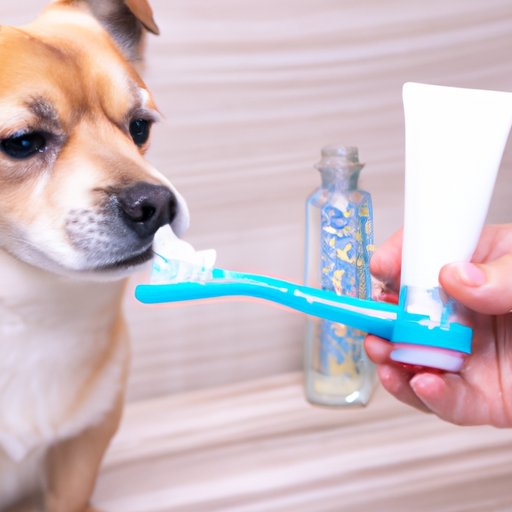
I. Introduction
As pet owners, one of our responsibilities is to take care of our furry friend’s overall health, and that includes their dental health. Brushing your dog’s teeth may seem like a daunting task, but it’s more important than you think. Neglecting your dog’s teeth can lead to serious health issues such as gum disease, which can affect their overall wellbeing. In this article, we’ll guide you on ways to brush your dog’s teeth and why it’s essential.
II. Why Dental Care is Important for Your Furry Friend and Ways to Brush the Dog Teeth
Dental care is vital for your dog’s general health. Poor dental hygiene can lead to bad breath, cavities, and gum disease, among others. Brushing your dog’s teeth regularly helps prevent these problems, which can be painful for your furry friend. To start brushing your dog’s teeth, ensure you have dog-friendly toothpaste, which is different from human toothpaste. Also, pick a toothbrush that fits your dog’s mouth size. You can opt for a finger brush for small dogs or children’s toothbrush or a long handle brush for bigger breeds. For dogs that are new to tooth brushing, start by introducing them to the toothpaste and brushing for short periods, such as ten seconds until they get used to it.
III. Simple Steps for Brushing Your Dog’s Teeth
Brushing your dog’s teeth might seem challenging, but it’s easier than it looks. Here is a simple guide on how to brush your dog’s teeth:
- Start by placing a small amount of dog-friendly toothpaste onto your finger and gradually introduce your dog to it.
- Once your dog is familiar with the toothpaste, place some on the toothbrush and start brushing in a circular motion on the gum line.
- Brush the outer surfaces of your dog’s teeth using gentle back and forth motions.
- Finish by brushing the inside of the teeth using the same technique.
- Reward your dog with treats or praise after brushing to make it a positive experience.
IV. Brushing Your Dog’s Teeth: The Ultimate Guide
Suppose you’ve been brushing your dog’s teeth for a while, and you’re looking for ways to make the process more effective. In that case, the ultimate guide to brushing your dog’s teeth is what you need. Firstly, ensure you have a comfortable and calm environment. Dogs can sense anxiety or tension from their owners, making the process more difficult. When brushing your dog’s teeth, focus on the gum line as it’s the area where plaque and bacteria accumulate. Use a soft-bristled brush or gauze to clean between the teeth, and use circular motions to ensure all areas are covered. Remember to brush the sides of the teeth and finish with rewarding your furry friend to make the experience enjoyable.
V. The Do’s and Don’ts of Brushing Your Dog’s Teeth
Brushing your dog’s teeth has some dos and don’ts. For example, always use dog-friendly toothpaste as some human toothpaste contains ingredients harmful to dogs. Also, don’t use a brush with stiff bristles as it can damage your dog’s gums. Other tips include:
- Start brushing your dog’s teeth while they’re young to make it a routine.
- Brush your dog’s teeth at least twice a week, although daily brushing is ideal.
- Avoid using human mouthwash or other dental products for dogs unless prescribed by a veterinarian.
- Don’t neglect your dog’s dental check-ups and cleaning.
VI. Teeth Brushing 101: How to Keep Your Dog’s Smile Bright
Brushing your dog’s teeth is one way to keep their smile bright, but there are other ways. You can provide dental treats and chews that help clean your dog’s teeth as they chew. Giving your dog’s dry kibble instead of wet food can help keep their teeth clean. There are also dental sprays and water additives that help reduce plaque and tartar build-up. Regular dental check-ups and cleaning from a veterinarian can also help detect and treat any dental problems before they escalate.
VII. The Benefits of Brushing Your Dog’s Teeth and How to Do it Right
The benefits of brushing your dog’s teeth go beyond just improving their dental hygiene. Regular brushing can prevent heart, liver, and kidney diseases that result from bacteria in the mouth spreading throughout the body. Brushing your dog’s teeth also enhances their breath, which means more cuddles and kisses for you both. To do it right, start slow, use dog-friendly toothpaste, pick the right brush, brush regularly and avoid rushing the process. Also, don’t forget to reward your dog for good behavior.
VIII. 5 Tips for Making Dog Teeth Brushing a Breeze
To make dog teeth brushing easier for you and your furry friend, here are five practical tips:
- Start introducing your dog to toothbrushing when they’re young to get them familiar with the process.
- Use positive reinforcement during the brushing process by rewarding your dog with treats or praise.
- Choose a convenient time to brush your dog’s teeth that suits both of you.
- Try different toothpaste flavors and types to find one that your dog loves.
- Allow your dog to smell the toothpaste and brush before starting the process to get them comfortable.
IX. Conclusion
Brushing your dog’s teeth might seem like a challenging task, but it’s essential to their overall health. Regular brushing, using dog-friendly toothpaste, and tools, will not only prevent dental problems but also promote their general health. By following the simple steps outlined in this article, and with patience, perseverance, and positive reinforcement, you can make toothbrushing a breeze for you and your furry friend.




